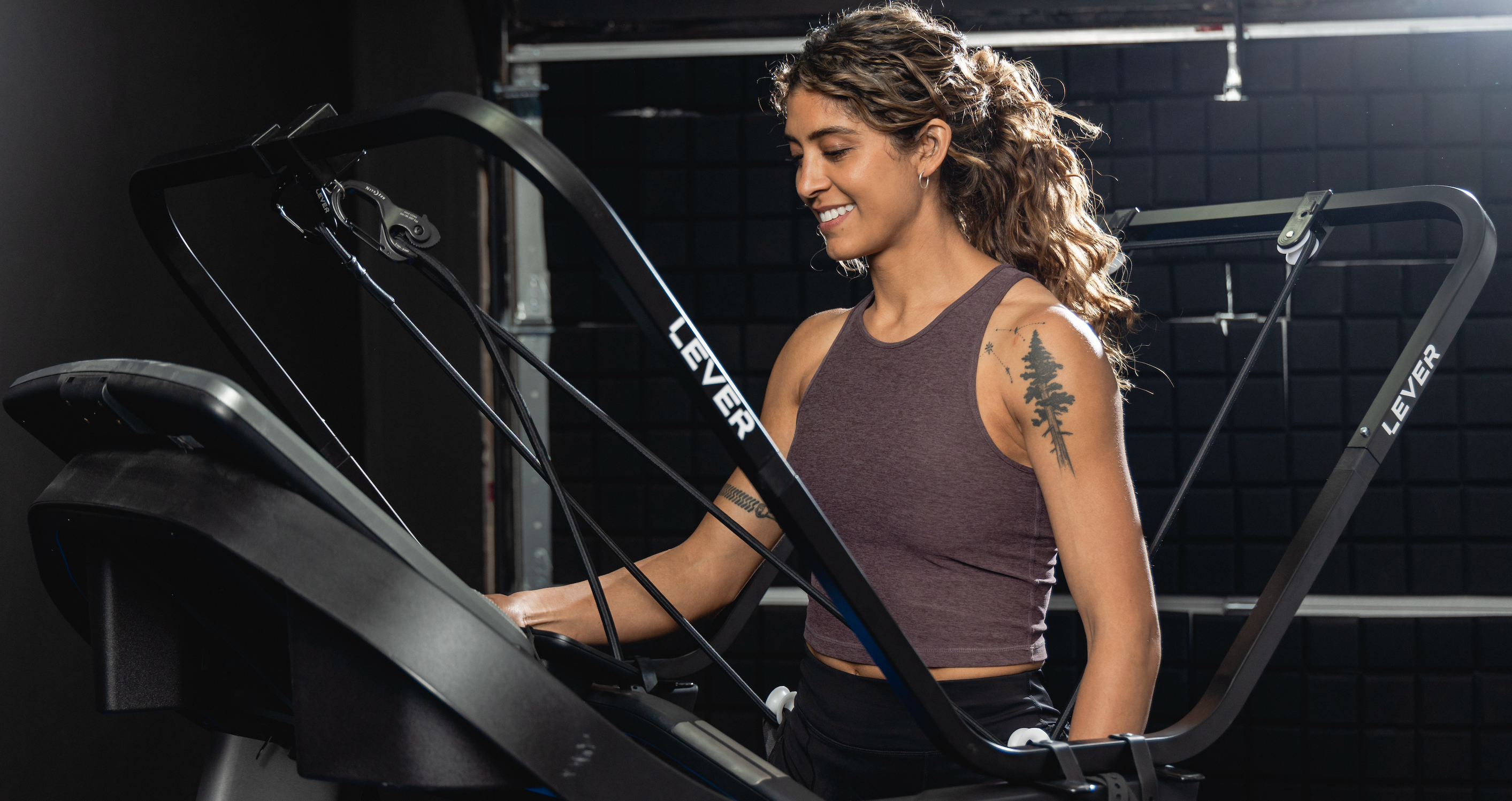Frequently Asked Questions
What is LEVER Movement?
LEVER Movement is a community of athletes that are pushing the boundaries of fitness. By spending less time on the injury sidelines, LEVER Running athletes are unlocking their true potential, setting records, and always Racing to WIN.
What is the LEVER System?
The LEVER system is a continuously evolving body weight support device from LEVER. It is a novel body weight support device that is designed for use with standard home and commercial treadmills. The LEVER system uses a tensioning cam system and elastic cord to reduce weight on its users.
Why should I run with a LEVER System?
Athletes use their LEVER to increase fitness, recover post-injury, practice technique and more!
Why is it important to load a tendon while recovering from that injury?
Loading a tendon during recovery from an injury is crucial for several fundamental reasons, grounded in the biology of tendon repair and the principles of rehabilitation. Here's why:
- Stimulates Healing: Tendons receive relatively low blood flow compared to other tissues, which can slow down the healing process. Applying controlled mechanical stress through loading increases blood circulation to the area, bringing essential nutrients and oxygen that aid in the repair process. This stimulation encourages the proliferation of tenocytes, the cells responsible for synthesizing the collagen that tendons are primarily composed of.
- Promotes Collagen Synthesis: The healing process involves the production of collagen, the main structural protein in tendons. Loading encourages the alignment of collagen fibers along the lines of stress, enhancing the structural integrity and function of the healed tendon. Without appropriate loading, the newly formed collagen might not align properly, resulting in a weaker tendon susceptible to re-injury.
- Prevents Muscle Atrophy and Joint Stiffness: Inactivity or immobilization can lead to muscle atrophy and joint stiffness, complicating the recovery process. Controlled loading exercises maintain muscle strength and joint range of motion, which are crucial for supporting and stabilizing the injured tendon during and after recovery.
- Facilitates Remodeling: Tendons undergo a remodeling process after injury, where the initially laid down collagen is matured and organized. Loading is critical in this phase, as it helps in the maturation of collagen fibers, improving the tendon's mechanical properties, and ensuring that the tendon can withstand the stresses of daily activities and sports.
- Reduces Risk of Chronic Tendinopathy: Properly applied load management can help avoid the development of chronic tendinopathy. Chronic tendinopathy can arise from inadequate healing, characterized by ongoing pain and decreased function. Progressive loading helps ensure that the tendon regains its strength and elasticity, reducing the risk of transitioning from an acute to a chronic condition.
- Enhances Proprioception: Loading exercises improve proprioception, or the sense of joint position and movement, which is often compromised after an injury. Enhanced proprioception is crucial for avoiding awkward movements that could strain the healing tendon and for returning to pre-injury levels of activity.
It's essential to note that the loading should be gradual and carefully managed. Starting with low-intensity exercises and progressively increasing the load as the tendon's capacity improves helps prevent overloading the healing tissue. This approach should ideally be guided by a healthcare professional, such as a physical therapist, who can tailor the rehabilitation program to the individual's specific needs, progress, and the particular tendon injured.
Why is it important to load a bone while returning from a stress fracture?
Loading a bone while recovering from a stress fracture is important for several key reasons related to the biology of bone healing and adaptation. Controlled, gradual loading can facilitate a more effective and efficient recovery process:
- Stimulates Bone Remodeling and Healing: Bones adapt to the stresses placed upon them through a process known as Wolff's Law, which states that bones in a healthy person or animal will adapt to the loads under which they are placed. Controlled loading after a stress fracture encourages the deposition of new bone material and strengthens the area of the fracture, promoting healing.
- Prevents Disuse Osteoporosis: Avoiding loading a bone after a fracture can lead to disuse osteoporosis, a condition where the bone loses density and becomes more fragile due to inactivity. Gradual loading helps maintain bone density and reduces the risk of further fractures.
- Improves Functional Recovery: Gradual loading as part of rehabilitation helps ensure that once the bone has healed, it can withstand normal activities. This approach helps in regaining strength, flexibility, and endurance in the muscles supporting the injured bone, contributing to a better functional recovery.
- Enhances Circulation: Controlled physical activity and loading improve circulation to the injured area, which is crucial for healing. Increased blood flow delivers essential nutrients and oxygen to the bone, supporting the repair process.
- Facilitates Proprioception and Balance: The process of gradually loading the bone and engaging in weight-bearing activities as tolerated helps improve proprioception— the body's ability to sense movement, action, and location. It also aids in restoring balance, both of which are crucial for preventing future injuries.
- Encourages Collagen Alignment: During the bone healing process, collagen fibers form as part of the callus in the early stages of bone repair. Controlled loading helps align these fibers along the lines of mechanical stress, which is essential for the structural integrity and strength of the healed bone.
- Prevents Joint Stiffness and Muscle Atrophy: Gradual and controlled loading prevents joint stiffness and muscle atrophy that can result from prolonged periods of immobilization. Keeping the muscles and joints active through controlled loading helps maintain range of motion and muscle strength around the injured bone.
It's crucial that the loading is introduced progressively, guided by healthcare professionals such as physical therapists or orthopedic specialists. They can provide personalized rehabilitation plans based on the specific location and severity of the stress fracture, the patient's overall health status, and their activity levels before the injury. Starting with low-impact activities and gradually increasing the intensity and volume of loading ensures that the bone heals correctly while minimizing the risk of re-injury.
Does Body Weight Support help in Injury Recovery?
Yes! See the video below-
A new era of training is here! Watch the video below-VIDEO
A new era of training is here! Watch the video below-
How much body weight can I take off using the LEVER system?
Currently, the LEVER system has a 45 pound maximum weight take-off limit.
How much weight off is each marker on the bungee? (ONLY FOR THE LEVER UP SYSTEM)
Each mark on the bungee is separated at about 8 pounds (3.5 kg) increments. Only for the LEVER UP system.
What treadmills work best with the LEVER system?
LEVER works with a broad range of treadmills. Nordictrack, Peloton, Sole, and Proform, are just some of the treadmills we work great with. We also work with the Woodway 4Front treadmill! Check out our Woodway adapters on our shop.
How long does it take to ship internationally?
Shipping internationally typically takes 4-7 business days.
How does your rent to buy program work?
Rentals can be bought out at anytime. When the customer is ready to buy, we will send an invoice for the remaining balance of the LEVER system.
How to download the LEVER App?
To download the LEVER app:
For iOS (Apple Devices):
Open the App Store on your device.
Search for “LEVER Running”
Tap “Download” or “Get” to install the app.
For Android Devices:
Open the Google Play Store on your device.
Search for “LEVER Running”
Tap “Install” to download the app.
USER GUIDES & INSTALLATION
How do you set up the LEVER System?
The LEVER system takes about 2-3 minutes to assemble/disassemble. Please see our how-to video for more information on how to set up your LEVER.
How to set up the LEVER GO+
Learn how to set up the LEVER GO+
LEVER Precision Scale Guide
Installing the LEVER Precision Scale
1. It is important to install the scale onto the front bar and not the back bar. The on button of the scale should face the same direction as the connector on the front bar.
2. Slide the scale through the bar and push it through the bent section of the front bar. For some LEVER models this will be easier than others.
3. Position scale to desired placement to mirror the right cube
4. To secure the scale on the front bar, tighten the screws with the allen keys.
Precision Scale Connection
Precision Scale Connection:
Watch Video
Step 1. Open the LEVER App and hit “Start New Session”
Step 2. Turn on the Precision Scale. You will see the red light flash once, indicating that the Precision Scale is turned on and ready for bluetooth connection (all bluetooth connection will be done through the LEVER App, not your phone or device’s bluetooth library).
Step 3. Hit “Continue” this will begin the Precision Scale’s Bluetooth connection. Once you see 0lbs/100% on the screen you will then insert the bungee into the CamJam and begin taking weight off until the desired amount is reached. You should not have any tension on the bungee while the Precision Scale is establishing the connection.
*Reminder: 45lb maximum
Step 4. Connect your Heart Rate Monitor if you would like to
Begin your run!
Can't find what you're looking for?
Send us an email to our Customer Service team will get back to you as soon as possible. Be sure to include your order number (if you have one).
Please email us at inquiry@leverrunning.com


